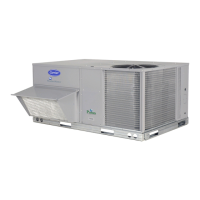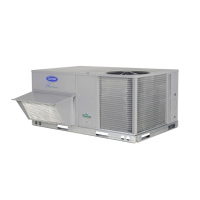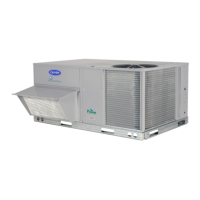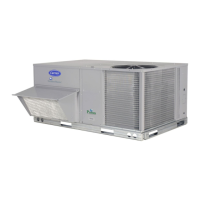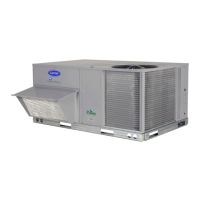36
Table 13 – RTU Open Controller Inputs and Outputs
POINT NAME
BACnet OBJECT
NAME
TYPE OF I/O
CONNECTION PIN
NUMBER(S)
CHANNEL DESIGNATION
DEDICATED INPUTS
Space Temp / Zone Temp zone_temp AI (10K Thermistor) J20-1 & 2 Analog Input 10
Supply Air Temperature sa_temp AI (10K Thermistor) J2-1 & 2 Analog Input 6
Outside Air Temperature oa_temp AI (10K Thermistor) J2-3 & 4 Analog Input 7
Space Temperature Offset Pot stpt_adj_offset AI (100K Potentiometer) J20-3 & 4 Analog Input 11
Safety Chain Feedback safety_status BI (24 VAC) J1-9 Binary Input 4
Compressor Safety Status
(1)
comp_status BI (24 VAC) J1-2 Binary Input 3
Fire Shutdown Status firedown_status BI (24 VAC) J1-10 Binary Input 5
Enthalpy Status enthalpy_status BI (24 VAC) J2-6 & 7 Binary Input 8
Humidistat Input Status humstat_status BI (24 VAC) J5-7 & 8 Binary Input 9
Zone Temperature n/a n/a J13-1-4 Rnet
CONFIGURABLE INPUTS
(4)
Indoor Air CO2 iaq AI (4-20 mA)
J4-2 & 3 or J4-5 & 6
Analog Input 2
Outdoor Air CO2 oaq AI (4-20 mA) Analog Input 1
Space Relative Humidity space_rh AI (4-20 mA) Analog Input 10
Supply Fan Status
(2)
sfan_status BI (24 VAC)
J5-1 & 2 or J5-3 & 4,
J5-5 & 6 or J5-7 & 8
(3)
Binary Input 3, 5, 8, or 9, except where intrinsic input is used
Filter Status
(2)
filter_status BI (24 VAC) Binary Input 3, 5, 8, or 9, except where intrinsic input is used
Door Contact
(2)
door_contact_status BI (24 VAC) Binary Input 3, 5, 8, or 9, except where intrinsic input is used
Remote Occupancy input
(2)
occ_contact_status BI (24 VAC) Binary Input 3, 5, 8, or 9, except where intrinsic input is used
IGC input
(2)
igcovr_status BI (24 VAC) Binary Input 9. Mandatory input on gas heat units.
OUTPUTS
Economizer Output econ_output AO (4-20mA) J2-5 Analog Output 1
Supply Fan VFD vfd_output AO (2-10Vdc) J22-1 & 2 Analog Output 2
Supply Fan Relay sfan BO Relay (24VAC, 1A) J1-4 Binary Output 1 (G)
Cool 1 Relay State comp_1 BO Relay (24VAC, 1A) J1-8 Binary Output 5 (Y1)
Cool 2 Relay State comp_2 BO Relay (24VAC, 1A) J1-7 Binary Output 4 (Y2)
Cool 3 Relay State comp_3 BO Relay (24VAC, 1A) J11-5 & 6 Binary Output 7 (Y3)
Heat 1 Relay State heat_1 BO Relay (24VAC, 1A) J1-6 Binary Output 3 (W1)
Heat 2 Relay State heat_2 BO Relay (24VAC, 1A) J1-5 Binary Output 2 (W2)
Power Exhaust Relay State pexh BO Relay (24VAC, 1A) J11-2 & 3 (N.O.) Binary Output 8 (PE)
Dehumidification Relay dehum BO Relay (24VAC, 1A) J11-7 & 8 (N.O.) Binary Output 6
LEGEND
AI - Analog Input
AO - Analog Output
BI - Binary Input
BO - Binary Output
(1)
Safety Chain Feedback: 24Vac required at this terminal to provide “Run Enable” status. See Input/Output section for additional instructions.
(2)
These inputs are configurable. If installed, they take the place of the default input on the specific channel. See appropriate Input Configuration Section for wiring and setup instructions.
(3)
Parallel pins J5-1 = J2-6, J5-3 = J1-10, J5-5 = J1-2 are used for field installation.
(4)
Refer to the input configuration and accessory sections of the RTU Open Multi-Protocol Controller Controls, Start-Up, Operation and Troubleshooting manual for more detail.
The RTU Open controller requires the use of a Carrier
space sensor. A standard thermostat cannot be used with
the RTU Open system.
Supply Air Temperature (SAT) Sensor —
On FIOP−equipped 50HCQ unit, the unit is supplied with
a supply−air temperature (SAT) sensor (33ZCSENSAT).
This sensor is a tubular probe type, approx 6−inches (152
mm) in length. It is a nominal 10k ohm thermistor.
The SAT is factory−wired. The SAT probe is wire−tied to
the supply−air opening (on the horizontal opening end) in
its shipping position. Remove the sensor for installation.
Re−position the sensor in the flange of the supply−air
opening or in the supply air duct (as required by local
codes). Drill or punch a
1
/
2
−in. hole in the flange or duct.
Use two field−supplied, self−drilling screws to secure the
sensor probe in a horizontal orientation. See Fig. 40.
Outdoor Air Temperature (OAT) Sensor —
The OAT is factory−mounted in the EconoMi$er2 (FIOP
or accessory). It is a nominal 10k ohm thermistor attached
to an eyelet mounting ring.
EconoMi$er2 —
The RTU Open controller is used with EconoMi$er2
(option or accessory) for outdoor air management. The
damper position is controlled directly by the RTU Open
controller; EconoMi$er2 has no internal logic device.
Outdoor air management functions can be enhanced with
field−installation of these accessory control devices:
Enthalpy control (outdoor air or differential sensors)
Space CO
2
sensor
Outdoor air CO
2
sensor
Field Connections
Field connections for accessory sensors and input devices
are made to the RTU Open controller at plugs J1, J2, J4,
J5, J11 and J20. All field control wiring that connects to
the RTU Open controller must be routed through the
raceway built into the corner post as shown in Fig. 31.
The raceway provides the UL required clearance between
high and low−voltage wiring. Pass the control wires
through the hole provided in the corner post, then feed the
wires thorough the raceway to the RTU Open controller.
Connect to the wires to the removable Phoenix connectors
and then reconnect the connectors to the board.
50HCQ

